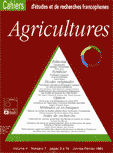Traitement du manioc, propriétés des farines et qualité du "foufou"
Résumé
"Fufu" is a cassava foodstuff made from 3-day fermented cassava flour and hot water. The traditional processing technique consists in steeping until soft, washing the softened roots, removing the fibres, pulverising into chips, and sun-drying. Once dried, the chips are ground and sifted. Manufacturing the flour using the fermentation process, however, is arduous and time-consuming, thus reducing the availability and distribution of fufu flour. Preliminary studies have shown that short-cut processing methods may prove technologically worthwhile for their simplicity and higher flour yield (32% on a peeled root basis, compared with 23% for the traditional method). The specific objectives of the study were to compare the traditional with three short-cut methods for fufu performance and flour properties. The short-cut processing methods were as follows : 1) the roots were shredded, then pressed, dried and ground; 2) the roots were shredded and 24-hour fermented, then pressed ; 3) the roots were shredded and 24-hour soaked, then pressed. The traditional method involved soaking the roots for 3-5 days, washing and fibre removal, then pressing. The acceptability and sensory characteristics of fufu (odour, kneadability and ease of making) were evaluated on a 5-point scale. The flour's water retention coefficients and viscosity characteristics were determined. The results show that traditional fufu had higher sensory scores than the other three treatments (table 1). Traditional flour had a lower peak viscosity (400 Brabender units [BU]; figure 1) and water retention coefficient (WRC: 3.21) than the others (825 BU and 3.52; table 1). There was a significant negative correlation (r \= - 0.98) between the WRC of the flour and kneadability of the fufu, thus suggesting the lower the WRC, the easier the preparation. We conclude that the best method of producing fufu flour remains the traditional soaking fermentation technique. Fufu flour should have a WRC of about 3.21 and a peak viscosity of about 400 BU. Furthermore, fufu should also have a specific aroma (fufu odour) and be easy to knead.Téléchargements
Publié
1995-01-01
Comment citer
Tiky Mpondo, G. . (1995). Traitement du manioc, propriétés des farines et qualité du "foufou". Cahiers Agricultures, 4(1), 57–59 (1). Consulté à l’adresse https://revues.cirad.fr/index.php/cahiers-agricultures/article/view/29869
Numéro
Rubrique
Articles

